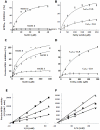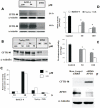Acylpeptide hydrolase inhibition as targeted strategy to induce proteasomal down-regulation
- PMID: 22016782
- PMCID: PMC3189933
- DOI: 10.1371/journal.pone.0025888
Acylpeptide hydrolase inhibition as targeted strategy to induce proteasomal down-regulation
Abstract
Acylpeptide hydrolase (APEH), one of the four members of the prolyl oligopeptidase class, catalyses the removal of N-acylated amino acids from acetylated peptides and it has been postulated to play a key role in protein degradation machinery. Disruption of protein turnover has been established as an effective strategy to down-regulate the ubiquitin-proteasome system (UPS) and as a promising approach in anticancer therapy.Here, we illustrate a new pathway modulating UPS and proteasome activity through inhibition of APEH. To find novel molecules able to down-regulate APEH activity, we screened a set of synthetic peptides, reproducing the reactive-site loop of a known archaeal inhibitor of APEH (SsCEI), and the conjugated linoleic acid (CLA) isomers. A 12-mer SsCEI peptide and the trans10-cis12 isomer of CLA, were identified as specific APEH inhibitors and their effects on cell-based assays were paralleled by a dose-dependent reduction of proteasome activity and the activation of the pro-apoptotic caspase cascade. Moreover, cell treatment with the individual compounds increased the cytoplasm levels of several classic hallmarks of proteasome inhibition, such as NFkappaB, p21, and misfolded or polyubiquitinylated proteins, and additive effects were observed in cells exposed to a combination of both inhibitors without any cytotoxicity. Remarkably, transfection of human bronchial epithelial cells with APEH siRNA, promoted a marked accumulation of a mutant of the cystic fibrosis transmembrane conductance regulator (CFTR), herein used as a model of misfolded protein typically degraded by UPS. Finally, molecular modeling studies, to gain insights into the APEH inhibition by the trans10-cis12 CLA isomer, were performed.Our study supports a previously unrecognized role of APEH as a negative effector of proteasome activity by an unknown mechanism and opens new perspectives for the development of strategies aimed at modulation of cancer progression.
Conflict of interest statement
Figures






Similar articles
-
APEH Inhibition Affects Osteosarcoma Cell Viability via Downregulation of the Proteasome.Int J Mol Sci. 2016 Sep 23;17(10):1614. doi: 10.3390/ijms17101614. Int J Mol Sci. 2016. PMID: 27669226 Free PMC article.
-
RedOx status, proteasome and APEH: insights into anticancer mechanisms of t10,c12-conjugated linoleic acid isomer on A375 melanoma cells.PLoS One. 2013 Nov 19;8(11):e80900. doi: 10.1371/journal.pone.0080900. eCollection 2013. PLoS One. 2013. PMID: 24260504 Free PMC article.
-
A novel class of protease targets of phosphatidylethanolamine-binding proteins (PEBP): a study of the acylpeptide hydrolase and the PEBP inhibitor from the archaeon Sulfolobus solfataricus.Mol Biosyst. 2010 Dec;6(12):2498-507. doi: 10.1039/c005293k. Epub 2010 Oct 12. Mol Biosyst. 2010. PMID: 20941418
-
The ubiquitin-proteasome system as a drug target in cerebrovascular disease: therapeutic potential of proteasome inhibitors.Curr Opin Investig Drugs. 2005 Jul;6(7):686-99. Curr Opin Investig Drugs. 2005. PMID: 16044664 Free PMC article. Review.
-
Targeting the ubiquitin-proteasome pathway: an emerging concept in cancer therapy.Curr Top Med Chem. 2011 Dec;11(23):2888-905. doi: 10.2174/156802611798281311. Curr Top Med Chem. 2011. PMID: 21824109 Review.
Cited by
-
Assessing biomarkers and neuropsychological outcomes in rural populations exposed to organophosphate pesticides in Chile--study design and protocol.BMC Public Health. 2015 Feb 10;15:116. doi: 10.1186/s12889-015-1463-5. BMC Public Health. 2015. PMID: 25881174 Free PMC article.
-
Differential proteomics analysis of liver failure in peripheral blood mononuclear cells using isobaric tags for relative and absolute quantitation.Biomed Rep. 2017 Feb;6(2):167-174. doi: 10.3892/br.2016.835. Epub 2016 Dec 30. Biomed Rep. 2017. PMID: 28357068 Free PMC article.
-
APEH Inhibition Affects Osteosarcoma Cell Viability via Downregulation of the Proteasome.Int J Mol Sci. 2016 Sep 23;17(10):1614. doi: 10.3390/ijms17101614. Int J Mol Sci. 2016. PMID: 27669226 Free PMC article.
-
Identification of oxidized protein hydrolase as a potential prodrug target in prostate cancer.BMC Cancer. 2014 Feb 10;14:77. doi: 10.1186/1471-2407-14-77. BMC Cancer. 2014. PMID: 24512522 Free PMC article.
-
Biomonitoring of blood cholinesterases and acylpeptide hydrolase activities in rural inhabitants exposed to pesticides in the Coquimbo Region of Chile.PLoS One. 2018 May 2;13(5):e0196084. doi: 10.1371/journal.pone.0196084. eCollection 2018. PLoS One. 2018. PMID: 29718943 Free PMC article.
References
-
- Ciechanover A. Proteolysis: from the lysosome to ubiquitin and the proteasome. Nat Rev Mol Cell Biol. 2005;6:79–87. - PubMed
-
- Schwartz AL, Ciechanover A. Targeting proteins for destruction by the ubiquitin system: implications for human pathobiology. Annu Rev Pharmacol Toxicol. 2009;49:73–96. - PubMed
-
- Shah IM, Di Napoli M. The ubiquitin-proteasome system and proteasome inhibitors in central nervous system diseases. Cardiovasc Hematol Disord Drug Targets. 2007;7:250–273. - PubMed
-
- Rajkumar SV, Richardson PG, Hideshima T, Anderson KC. Proteasome inhibition as a novel therapeutic target in human cancer. J Clin Oncol. 2005;23:630–639. - PubMed
-
- Naujokat C, Sezer O, Zinke H, Leclere A, Hauptmann S, et al. Proteasome inhibitors induced caspase-dependent apoptosis and accumulation of p21WAF1/Cip1 in human immature leukemic cells. Eur J Haematol. 2000;65:221–236. - PubMed
Publication types
MeSH terms
Substances
LinkOut - more resources
Full Text Sources
Miscellaneous

